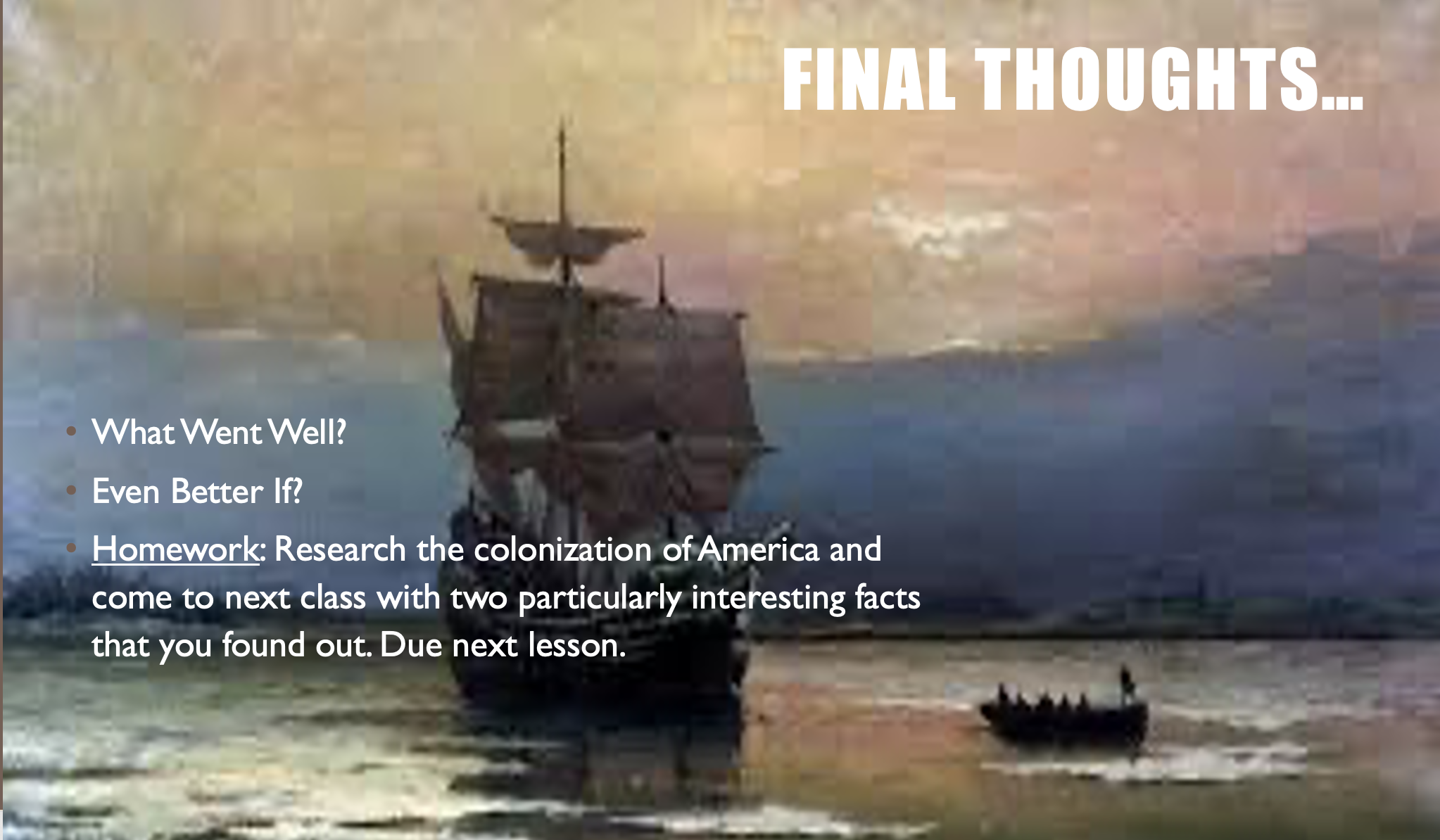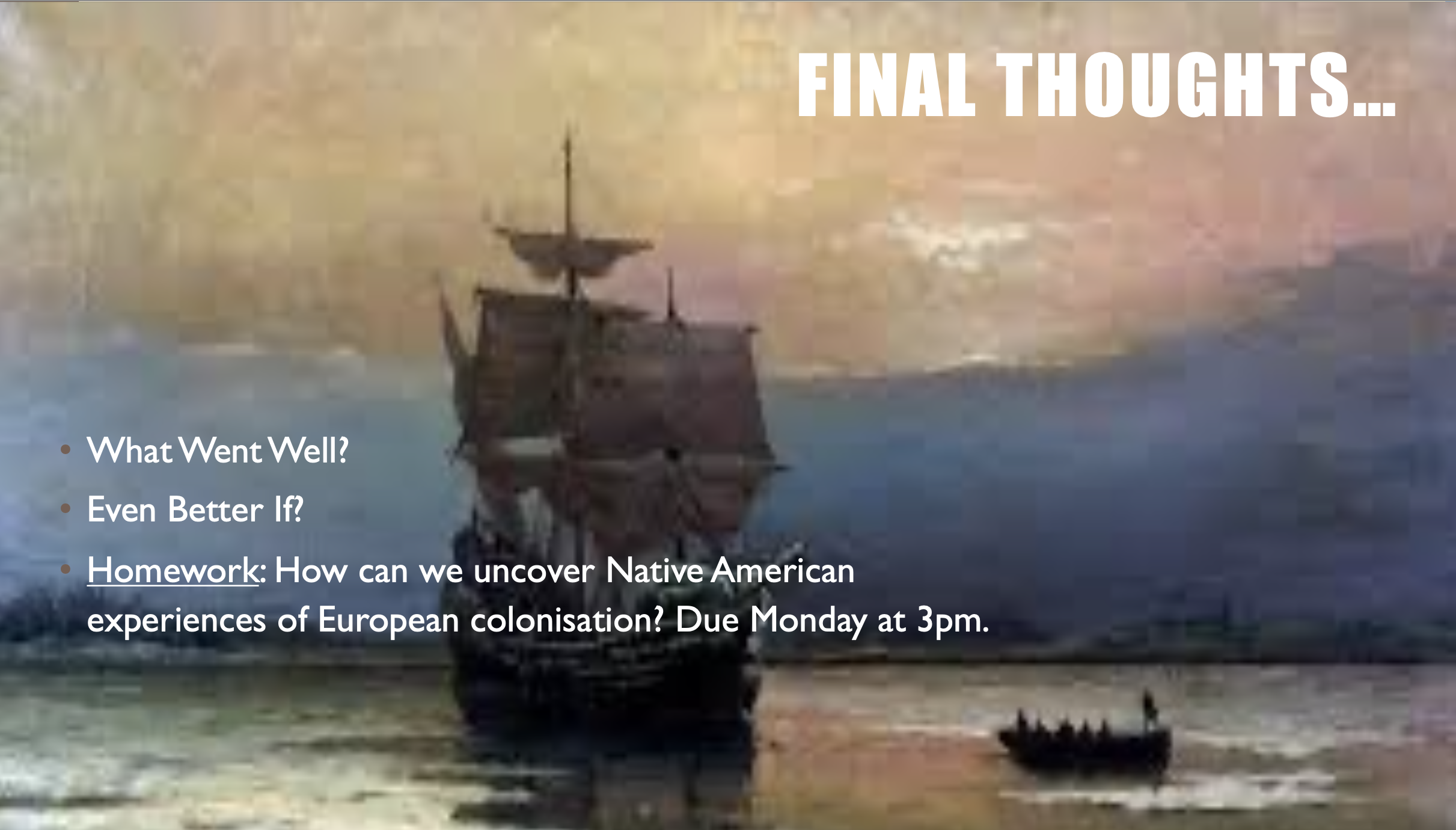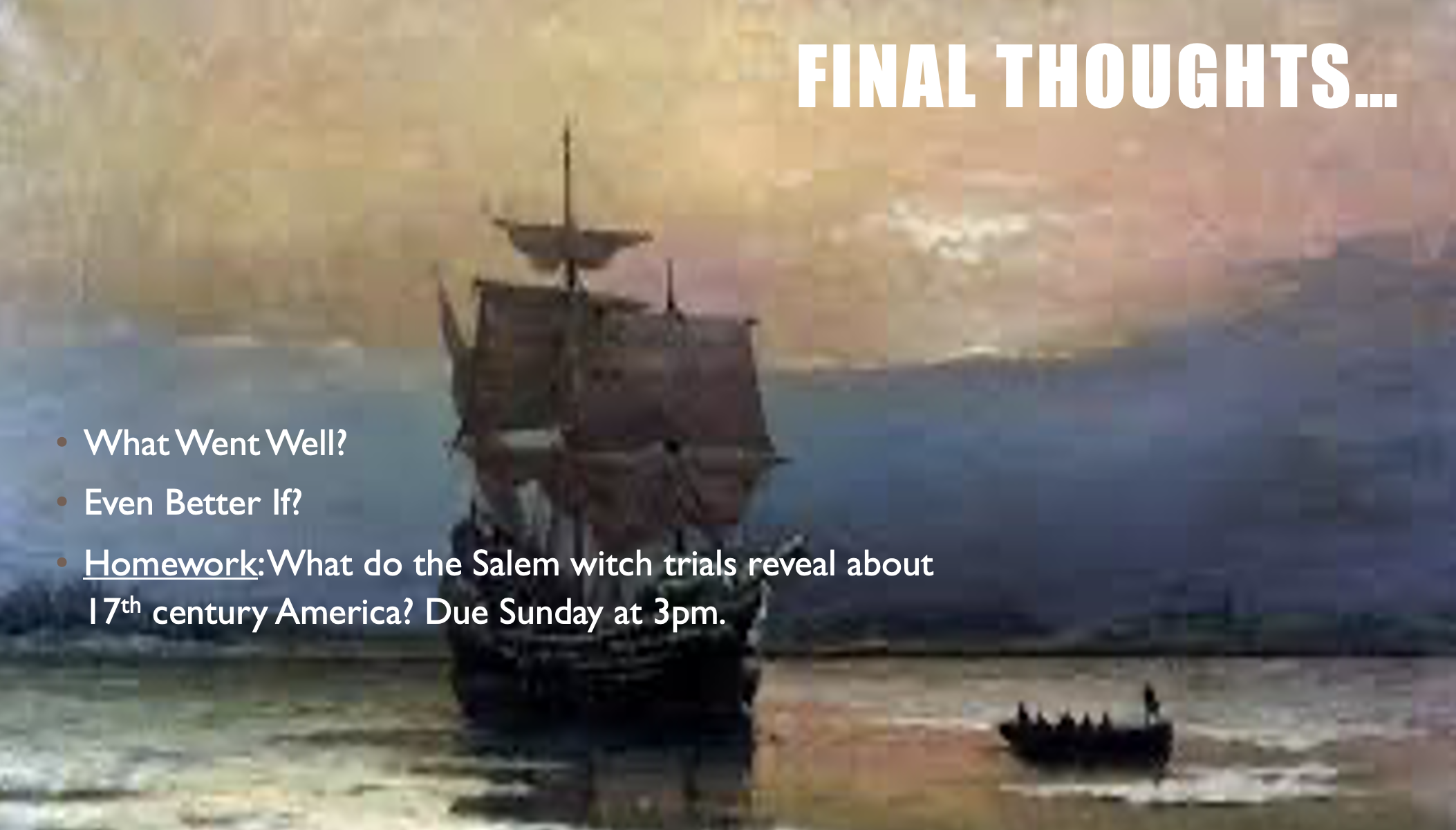› Forums › 2023 Summer Intensive Courses › HistoryEssayWriting-Wed
- This topic has 33 replies, 8 voices, and was last updated September 5, 2023 by
Beth.
-
AuthorPosts
-
-
at 12:39 #33451
Beth
ParticipantSummary for Lesson 1
In today’s class we began with our introduction to the history course, thinking about how to approach history in a way that acknowledges bias, thinks carefully about the purpose of historical study and grapples with the nature of historical truth. We began with some blind source analysis, before digging into the history of colonisation of the US and speaking about the role of the historian in society. The class thought about the concept of the balance of evidence and how to think of sources like evidence in a court case. Outstanding work today class, your ideas were sharp and analytical throughout and you all came up with some inspiring views on the role of history. Well done for your fab work and see you next week 🙂
Homework

Attachments:
You must be logged in to view attached files. -
at 16:05 #33462
Bowen
ParticipantThanks for the lesson! I have listed a few points here from homework:
History week 1:
c. 980 – c. 1030 Norse settlement established in Newfoundland, North America, by Leif Erikson.
1453 The Ottoman Empire closes the overland Silk Road trade routes between Europe and the East, initiating the European Age of Discovery.
1492 – 1504 Christopher Columbus makes four voyages to the New World; opens the way for European colonisation of the Americas.
1500 Brazil is claimed for Portugal by Pedro Álvares Cabral.
1519 – 1521 Hernán Cortés of Spain conquers the Aztec nation of Mexico.
1534 – 1535 North American region of Canada claimed for France by Jacques Cartier.
1572 The Inca of South America were conquered by Spanish conquistador Francisco Pizarro.
1587 – 1590 English colony of Roanoke in North America established and failed.
1607 – 1608 English Popham colony established in present day state of Maine, North America; fails after 14 months.
1607 – 1699 Colony of Jamestown succeeds as the first permanent English settlement in North America.
1609 – 1624 Hudson River Valley and parts of present-day New York State and Canada claimed by Henry Hudson for the Netherlands.
1620 – 1691 Plymouth Colony established in modern-day Massachusetts, North America; foundational colony of the later United States.
1697 The conquest of the Maya Civilization completed by the Spanish conquistador Martín de Ursúa. -
at 21:44 #33517
-
at 12:28 #33664
Beth
ParticipantSummary for Lesson 2
In today’s class we continued our work on the history of the USA, learning today about the early days in the colonisation of America. We began with the class sharing their research, before watching a video talking about the founding of the first colonies. We discussed the example of Roanoak and what this tells us about the experience of colonisers and thought about the impact and role of religion in light of this. We analysed a source from a children’s textbook in 1688 and finally talked through a step-by-step source analysis worksheet and an essay structure example. Wonderful work today class, well done for your attention to detail and interesting ideas about what we can learn from different examples of colony building. See you next week 🙂
John Green video: https://www.youtube.com/watch?v=o69TvQqyGdg
Homework

Attachments:
You must be logged in to view attached files. -
at 13:56 #33672
Alice
ParticipantHi Beth!
Thank you for the lesson! I have attached my homework for this week.
Attachments:
You must be logged in to view attached files.-
at 16:21 #33840
-
-
at 22:37 #33791
Amy
ParticipantThank you Beth for the lesson!
Attachments:
You must be logged in to view attached files.-
at 16:27 #33842
-
-
at 10:02 #33874
Beth
ParticipantSummary for Lesson 3
In today’s class we zoomed in on the central historical event of the course: the Salem witch trials. We began today by thinking about what we think of when we think of witchcraft, and what factors in society appear to lead to these beliefs. We then learned about the history of 17th-century Salem, discussing what happened in the witch trials and how the events unfolded. We spoke about what kind of threat witchcraft represented to people at this time, learned from a courtroom source of the supposed symptoms and discussed what this tells us about gender, class and religion at the time. Some good work today, everyone was a little quiet but came up with some fab answers when called upon. Well done guys, remember to have confidence in your contributions and I’ll see you next week 🙂
Salem trials video: https://www.youtube.com/watch?v=NVd8kuufBhM&themeRefresh=1
Homework

Attachments:
You must be logged in to view attached files.-
at 20:56 #33960
 PierceParticipant
PierceParticipantHello! I’m a little behind on the recordings due to a World Scout Jamborette but here’s my homework for lesson 2. I apologise for not being on top of things, but unfortunately, I can’t do two lessons whilst on a campsite so I’m making up for it in the last couple of days.
I will finish the third lesson as soon as possible. And my homework for lesson 1 seems to have not sent? So here it is again.
Apologies,
Pierce
Attachments:
You must be logged in to view attached files.-
at 18:14 #34055
-
-
-
at 23:07 #34062
Amy
ParticipantHi Beth,
Thank you for the lesson, here is my homework
Attachments:
You must be logged in to view attached files.-
at 22:14 #34344
-
-
at 10:07 #34064
Beth
ParticipantSummary for Lesson 4
In today’s class we worked on source analysis, building off the foundations we built last week when thinking about the Salem witch trials. We began with a discussion of what challenges Salem presents to the historian and what skills we need to analyse this period in history. We then thought about The Crucible, and what it can teach us about Salem when we read against the grain. The class then completed some excellent source analysis on two primary sources, thinking about purpose, author, content, tone, before we had some final discussions on types of sources that are helpful to the historian. Well done today everyone- you all came up with some lovely ideas about the challenges of researching an event like the Salem witch trials and thought about the purpose and tone of sources beautifully. Good luck revising for your mini mock next week and remember the extension is optional, I want you to focus mainly on revision and then you can do some source analysis if you would like as an extension. See you soon 🙂
Links for sources:
•https://lisahistory.net/pages/LUps.htm
•https://salem.lib.virginia.edu/generic.html
•https://www.danverslibrary.org/archive/annenberg-grant-report/Homework

Attachments:
You must be logged in to view attached files. -
at 17:34 #34088
Emma
ParticipantBeth, Here is my homework from the past few weeks.
2/8/23
The Boston Massacre
Why it was started
In the early 1770 more than 2000 British soldiers tried to enforce some British tax laws against the 16000 colonists in Boston. The colonists in America started to rebel against the taxes with the phrase “no taxation without representation”.
On February 22nd, a group of patriots attacked a loyalist’s store. Ebenezer Richardson, a local customs officer, tried to break up the fight by shooting his gun through the window of his house, which sadly hit an 11 year old boy called Christopher Seider which enraged the patriots even more.
A few days later, another fight broke out between the British soldiers and the patriots which led to the Boston Massacre.
How it happened
On the evening of March 5th, 1770, Hugh White was the only guard guarding the Custom House on Kings Street which contained all of the king’s riches. He was attacked by angry colonists who threatened violence against him.
As they started attacking him, he fought back and hit one man with his bayonet. Once the colonists figured that White hit a colonist, they started to throw snowballs and stones at him which made him call for reinforcements.
Due to the call for reinforcements, many soldiers took up a defensive position following the order of Captain Thomas Preston. Knowing that bloodshed was going to happen, many pleaded the British not to open fire while others dared them to fire.
During the chaos, someone supposedly shouted “Fire!” which caused a soldier to fire. After everyone had heard the shot, more shots were fired and 5 people were killed while 6 were wounded.
16/8/23
The Salem Witch Trials
The Salem Witch Trials reveals that the 17th century was a very strict period of time. At the time, the people living in Salem were tortured and killed from February 1692 to May 1693 due to the strictness of the Puritans who took control over Salem. Women were falsely accused of witchcraft and only freed if confessed and if you accuse someone else.
Emma
-
at 22:26 #34346
-
-
at 17:50 #34089
Emma
ParticipantSorry I missed the second part of the Salem witch trials. Sorry it was handed in late I didn’t have good connection in China.
Women were falsely accused of witchcraft and only freed if confessed and if you accuse someone else. This caused the number of people being accused of witchcraft to increase really quickly. People thought however that it was the devil just spreading it really quickly without thinking that innocent people are getting blamed for no reason.
-
at 21:28 #34134
Brian
ParticipantDear Beth,
Sorry for the late submission, I forgot to upload it.
Have a nice week!
Brian
Attachments:
You must be logged in to view attached files.-
at 22:33 #34350
-
-
at 09:54 #34368
Beth
ParticipantSummary for Lesson 5
In today’s class we completed our mock exam, bringing together all the skills and historical knowledge the class has amassed over the summer course and putting it into practice. The class chose between writing an essay or a source analysis and completed this with wonderful diligence and focus. Amazing work over the past five weeks everyone, well done. I will get your mocks marked over this week so remember to check back here for feedback and I will hopefully see you all in the next course. You’ve all done brilliantly this summer- keep up the great work 🙂
Homework

Attachments:
You must be logged in to view attached files. -
at 09:58 #34372
Bowen
ParticipantHello! Thanks for the lesson. Here is my history mock exam answer.
We all know what America is. A country famous for golden eagles, baseball and hot dogs. However, behind all that lies a darker secret. We will dive into the murky realms of America’s past, specifically at the Salem witch trials. I shall be talking about how the witch trials told us about the confusion, religious battle and gender separation which the American colonists faced.
The Salem witch trials were a series of hearings and prosecutions of people in Massachusetts between 1692 and may 1693. More than 200 people were accused of witchcraft, of which 30 were found guilty, 19 were hanged, and a man named Giles Corey died under torture for refusing to enter a plea. It was a dark time, with people arrested over the slightest bit of confusion. But why did these witch trials even happen?
People were mainly accused when people were confused. Strange happenings, such as robberies with no clear thief, or objects disappearing despite high security, or surviving a freak accident, could all end up with all the fingers pointing at you. But how can this injustice be stopped? Well, that is very difficult. Most people confessed to their “crimes” under torture, wanting it to end. And people who claimed to be innocent would most likely die regardless, such as Tituba, who, under pressure for her life and likely beaten into submission by Parris, she ultimately “confessed” to the crime. “The Devil came to me and bid me serve him,” she allegedly said. She described the Devil appearing as a “hog and sometimes like a great dog”; a “thing with a head like a woman with two legs and wings”; a hairy creature; a red rat and black rat; and a tall man in black clothes with white hair. She also confessed to riding on sticks with the children.. As I have mentioned before, confusion played a key role in this horrible bit of history. Nobody knew who to blame. They had lost something in a manner that was unknown. Naturally, people began to believe in the supernatural, especially after three young girls experienced fits of screaming, strange bodily contortions and murmuring incoherent sounds in January of 1692. The doctor had SUGGESTED that this was the cause of the supernatural, further proving that when people are confused, they come up with wild theories. This confusion was the key spark that ignited the start of the Salem witch trials.
Another key factor which contributed to the Salem witch trials was religion. The church used the structure of its teachings and the beliefs of its followers to construct a system that went against women and those accused of witchcraft. The actions of those accused were deemed as ungodly, demonic, and evil. Therefore, their perceived immorality led to much tension within the Church. Of course no one would approve of demons running around free, so they began to round up people whom they thought were the reasons for these strange events and began conducting tests on them to see if they were demonic or godly. As part of the infamous “swimming test,” accused witches were dragged to the nearest body of water, stripped to their undergarments, bound and then tossed in to see if they would sink or float. Since witches were believed to have spurned the sacrament of baptism, it was thought that the water would reject their bodies and prevent them from submerging.
According to this logic, an innocent person would sink like a stone, but a witch would simply bob on the surface. The victim typically had a rope tied around their waist so they could be pulled from the water if they sank, but it wasn’t unusual for accidental drowning deaths to occur. Witch swimming derived from the “trial by water,” an ancient practice where suspected criminals and sorcerers were thrown into rushing rivers to allow a higher power to decide their fate. This custom was banned in many European countries in the Middle Ages, only to reemerge in the 17th century as a witch experiment, and it persisted in some locales well into the 18th century. For example, in 1710, the swimming test was used as evidence against a Hungarian woman named Dorko Boda, who was later beaten and burned at the stake as a witch. But we still have one more factor to discuss on these horrible happenings.
Gender separation. An estimated 75% to 85% of those accused in the early modern witch trials were women, due to the fact that people accused the poor and helpless, mainly women. Women without husbands or widows were deemed dangerous due to the fact that there isn’t a male to “control them.” Most of the accused were young girls, typically below the age of 20. The youngest person was Dorothy. Dorothy and her mother Sarah were accused of practising witchcraft in Salem at the beginning of the Salem witch trials in 1692. Only four years old at the time, she was interrogated by the local magistrates, confessed to being a witch and purportedly claimed she had seen her mother consorting with the devil. As a result, she was confined in prison for nearly eight months.
Now we have seen the Salem witch trials and how confusion, religion and gender separation contributed to it. I hope I have helped you gain a deeper understanding of the Salem witch trials. Now as you go about America, disregarding all of the historic landmarks, just take in all of the great and horrible things which were pivotal in shaping America to the country it is today.
-
at 14:01 #34554
-
-
at 10:02 #34373
Emma
ParticipantHistory Essay
What role did religion play in the Salem Witch Trials? Were there more important factors motivating the trials?
Religion played a huge role in the Salem Witch Trials in the February of 1692, however are there more important factors like politics, loyalty and distrust, or is religion to blame?
The Salem Witch Trials are somewhat based on distrust and loyalty as it began after cousins Abigail Williams (11) and Elizabeth Parris (9) started having seizures in January 1692. The two children blamed Sarah Osborne, Sarah Good and Tituba for performing witchcraft on them. The three were taken into custody and judged. That was the only evidence given into court against the three women. The women all had something in common, that they all were ‘outcastes’ in one way or another. Tituba was Parris’ Indian slave, Sarah Good was a single mother and a beggar, and Sarah Osborne was a woman who had not attended church and was pregnant with a child. With the little evidence that they had, they convicted the three women of witchcraft.
Another cause of the Salem Witch Trials is religion. As the whole village of Salem was Puritan, they believed that if they confessed to their crime, they would be released as God would forgive them of their wrong doing. Therefore, Tituba confessed to practicing witchcraft and blamed Good and Osborne for influencing her. As she was released, she falsely accused others for witchcraft, which made people follow in her footsteps. Puritans also believed that ‘those who insisted upon their innocence met harsher fates, becoming martyrs to their own sense of justice.’ (Britannica, Salem Witch Trials) This led to both Osborne and Good to be imprisoned.
During the Salem Witch Trials, we can see that there were many factors that could be to blame for the Trials in Salem, although politics and religion play a big part in the trials, I believe that distrust and loyalty are the largest cause of the Trials.
-
at 14:12 #34556
-
-
at 10:04 #34374
Alice
ParticipantDear Beth,
Thank you so much for this amazing course! I have attached my history essay
Attachments:
You must be logged in to view attached files.-
at 14:23 #34558
-
-
at 10:05 #34376
Amy
ParticipantHi Beth,
Thank you for the lesson, here is my mock answer.
Amy
Attachments:
You must be logged in to view attached files.-
at 14:36 #34560
-
-
at 13:53 #34417
SofiaL
ParticipantThanks Beth for the lesson
have a lovely week
my mock exam is attached below.
I couldn’t finish,but I did my best
Sofia
Attachments:
You must be logged in to view attached files.-
at 14:44 #34562
-
-
-
AuthorPosts
- You must be logged in to reply to this topic.
